Are you on the hunt for the perfect guitar to strike the chords of your musical journey? Look no further than Wild Side Pawn & Jewelry, with locations in Stuart and Port St. Lucie, FL. Renowned for their diverse inventory of gently used guitars, Wild Side Pawn & Jewelry is a haven for musicians seeking quality instruments without breaking the bank.
A Symphony of Guitars: Explore Wildside Pawn’s Vast Inventory
Step into Wild Side Pawn & Jewelry, and you’ll find yourself surrounded by a symphony of guitars waiting to be played. Whether you’re a seasoned musician or budding artist, their extensive collection caters to every skill level and musical taste. From acoustic classics to electric marvels, Wild Side Pawn & Jewelry curates a range of gently used guitars that blend affordability with top-notch quality.
Quality Assurance: How Wildside Pawn Maintains Guitar Excellence
Wild Side Pawn & Jewelry takes pride in offering guitars that not only sound great, but also stand the test of time. Their commitment to maintaining the quality of each instrument sets them apart. Here are a few tips they employ to ensure every guitar in their inventory is a masterpiece:
- Stringent Inspection Process: Before a guitar finds its place in the showroom, it undergoes a thorough inspection. The experts at Wild Side Pawn & Jewelry carefully assess each instrument, checking for any signs of wear, damage, or issues that could affect its playability.
- Professional Setup: Wild Side Pawn & Jewelry understands the importance of a well-set-up guitar. Their team of skilled technicians ensures each instrument is professionally set up, guaranteeing optimal playability and tone. From adjusting the action to fine-tuning the intonation, your guitar from Wild Side Pawn & Jewelry arrives ready to rock.
- Expert Knowledge: The staff at Wild Side Pawn & Jewelry are not just sellers; they’re passionate musicians and guitar enthusiasts. Their in-depth knowledge allows them to guide customers in choosing the right guitar based on individual preferences and playing styles.
- Affordable Quality: Wild Side Pawn & Jewelry believes quality shouldn’t come with an exorbitant price tag. Their commitment to affordability ensures you can own a high-quality, gently used guitar without compromising your budget.
Wild Side Pawn and Jewerly Buys, Sells, and Pawns Gold, Silver, and Musical Instruments
At Wild Side Pawn and Jewelry, the allure of a treasure trove awaits, as they specialize in buying, selling, and pawning a diverse range of valuable items, including gold, silver, and musical instruments. As a trusted establishment, Wild Side Pawn offers customers the flexibility to pawning their precious belongings for a short-term loan or selling them outright. Pawning involves using an item as collateral for a loan, allowing individuals to retrieve their valuables upon repayment. On the other hand, selling involves permanently parting ways with the item in exchange for cash. With a keen eye for quality and fair assessments, Wild Side Pawn ensures a seamless and transparent process, whether customers choose to pawn or sell their items, creating a reliable haven for those seeking financial solutions or hunting for unique treasures.
https://youtu.be//lor6TOvmkw8?
10 Ways to Keep Your Electric Guitar in Top Condition
Electric guitars are not only musical instruments, but also valuable investments for any guitarist. To ensure your electric guitar stays in top condition and continues to deliver exceptional sound, it is crucial to prioritize regular maintenance and care. By implementing these ten essential tips, you can ensure your electric guitar remains in pristine condition year after year.
Understanding Your Electric Guitar
Before diving into the maintenance aspects, it is essential to familiarize yourself with the different parts of your electric guitar. By understanding the components, you can better grasp the importance of each maintenance step.
An electric guitar consists of several key components that work together to produce sound. The body is the main part of the guitar, typically made of wood, which provides resonance and support. Attached to the body is the neck, which houses the fretboard and the headstock. The fretboard is where you press down on the strings to produce different notes, while the headstock holds the tuning pegs.
The strings, usually made of steel or nickel, are stretched across the fretboard and produce sound when plucked or strummed. The pickups, located beneath the strings, capture the vibrations and convert them into electrical signals. These signals are then sent to the amplifier, which amplifies the sound and allows you to control various tonal aspects.
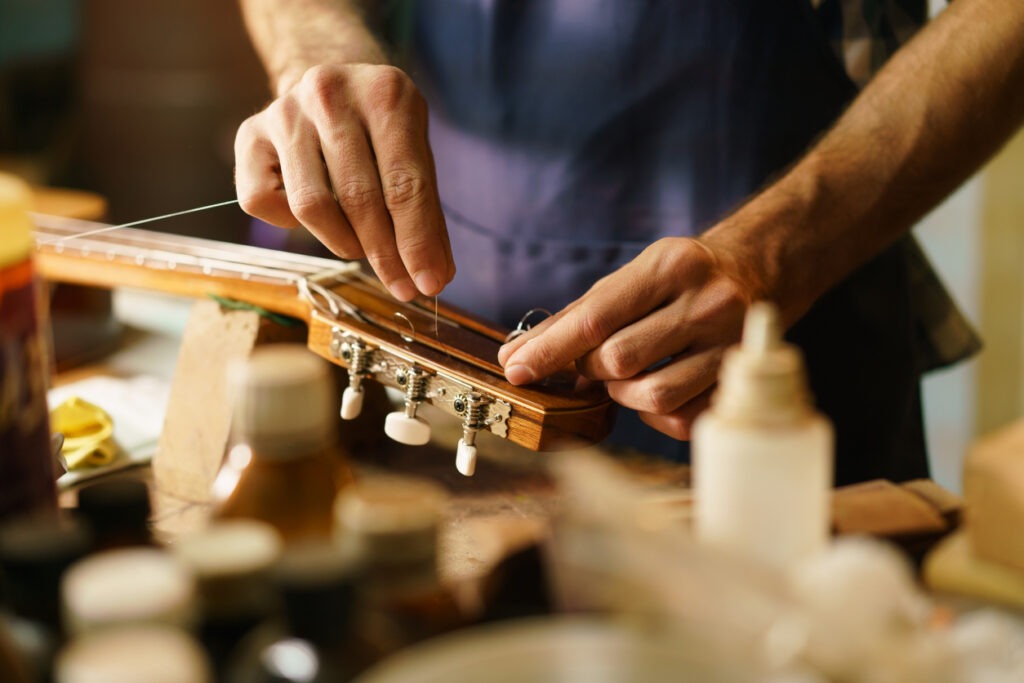
The Importance of Regular Maintenance
Regular maintenance is vital to keep your electric guitar performing at its best. It not only ensures optimal sound quality, but also extends the guitar’s lifespan. By properly maintaining your guitar, you can prevent structural damage and avoid costly repairs in the long run.
One crucial aspect of maintenance is keeping the guitar clean. Dust and dirt can accumulate on the body, fretboard, and strings, affecting sound quality and playability. Regularly wiping down the guitar with a soft cloth and using specialized guitar cleaning products can help maintain its appearance and performance.
Another essential maintenance task is string replacement. Over time, strings can become worn out, lose their brightness, and even break. By regularly changing your guitar strings, you ensure they are in optimal condition, providing better tone and playability.
Additionally, checking and adjusting the guitar’s intonation and action is crucial for optimal playability. Intonation refers to the accuracy of each string’s pitch across the fretboard, while action refers to the distance between the strings and the fretboard. Properly setting these aspects ensures that your guitar plays in tune and is comfortable to play.
Identifying Common Guitar Issues
Being able to identify common guitar issues is the first step in effectively maintaining your instrument. Issues such as buzzing strings, loose hardware, or electronic malfunctions can hinder your guitar’s performance. Stay vigilant and address these problems promptly to prevent further damage.
Buzzing strings can occur when the strings vibrate against the frets, causing an unwanted buzzing sound. This issue can be caused by various factors, such as improper string height, worn frets, or a warped neck. Identifying the source of the buzzing and taking appropriate action, such as adjusting the truss rod or filing down the frets, can resolve the issue.
Loose hardware, such as tuning pegs, bridge screws, or strap buttons, can affect the guitar’s stability and playability. Regularly checking and tightening these components ensures they are secure and prevents unwanted movement or rattling while playing.
Electronic malfunctions, such as crackling or cutting out of sound, can be caused by faulty wiring, loose connections, or worn-out components. Identifying the specific issue and seeking professional help or replacing the faulty parts can restore the guitar’s sound quality.
By understanding these common guitar issues and knowing how to address them, you can effectively maintain your electric guitar and keep it in optimal playing condition for years to come.
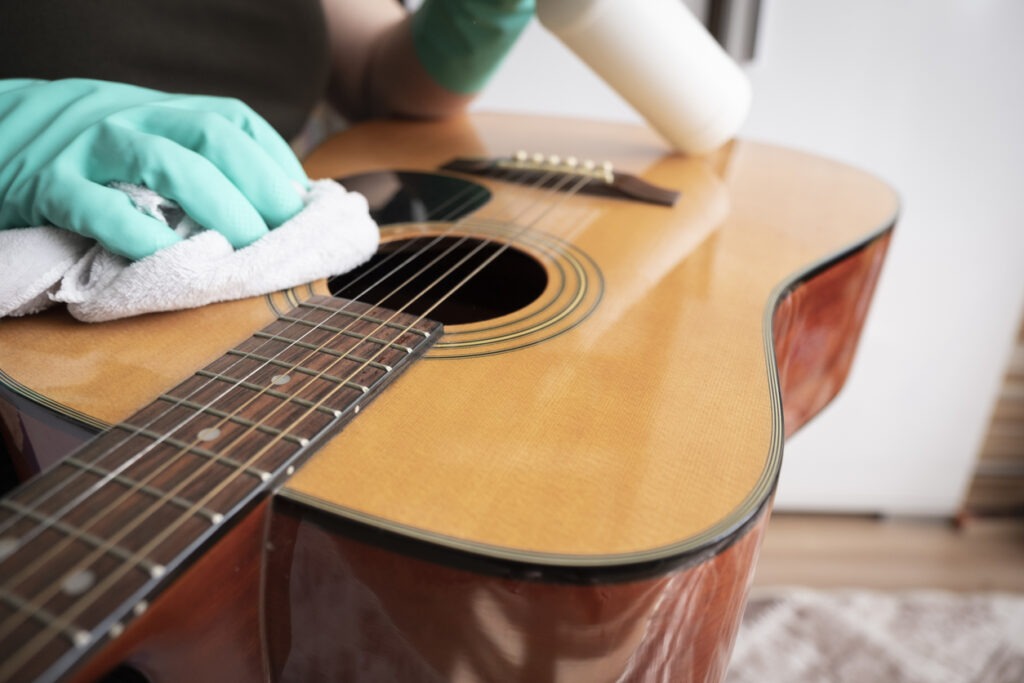
Cleaning and Polishing Your Guitar
Cleaning and polishing your electric guitar not only enhances its appearance, but also helps maintain its playability and longevity. Taking care of your instrument is essential for any guitarist, whether you’re a beginner or seasoned player. By following the right cleaning techniques and using the appropriate products, you can keep your guitar looking and sounding its best for years to come.
Choosing the Right Cleaning Products
When it comes to cleaning your electric guitar, using the right products is crucial. It’s important to remember that guitars are delicate instruments, and using the wrong cleaning solutions can cause irreversible damage. Always opt for specialized guitar cleaning solutions specifically designed to clean and protect the instrument’s finish.
These guitar cleaning solutions are formulated to remove dirt, fingerprints, and smudges without harming the guitar’s delicate finish. They are typically alcohol-free and contain ingredients that help preserve the wood and maintain the guitar’s natural shine. Avoid using abrasive cleaners or household cleaning products, as they can strip away the guitar’s finish and leave behind scratches.
The Proper Cleaning Technique
When cleaning your electric guitar, it is essential to be gentle and thorough. Start by wiping off any dust or debris with a soft microfiber cloth. This will prevent any particles from scratching the guitar’s surface during the cleaning process. Make sure to pay attention to hard-to-reach areas, such as the bridge and pickups, where dirt and grime can accumulate.
Next, using a mild guitar cleaner, apply a small amount to the cloth and gently clean the body, neck, and headstock. Work in small circular motions, being careful not to apply too much pressure. This will help remove any stubborn stains or fingerprints while protecting the guitar’s finish.
After cleaning, it’s important to wipe off all excess cleaner and moisture from the guitar. Leaving any residue behind can lead to a sticky or dull finish. Use a clean, dry cloth to thoroughly dry the guitar, ensuring no moisture remains.
Finally, to give your guitar a beautiful shine, polish the instrument using a clean cloth. You can use a specialized guitar polish or a high-quality microfiber cloth. Gently buff the guitar’s surface in circular motions, focusing on one section at a time. This will help restore the guitar’s natural luster and leave it looking brand new.
Remember, regular cleaning and maintenance are key to keeping your electric guitar in top condition. By following these cleaning techniques and using the right products, you can ensure your guitar remains clean, shiny, and ready to rock.
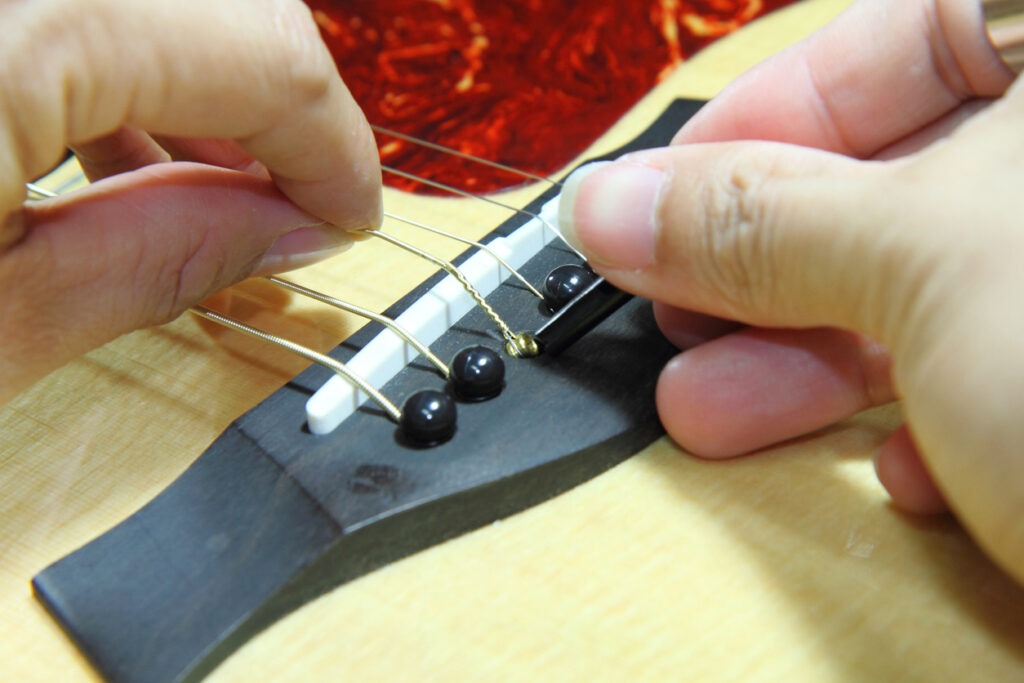
Changing Your Guitar Strings
Regularly changing your guitar strings is crucial for maintaining optimal tone and playability. Over time, strings become worn and lose their brightness. Here’s what you need to know:
When to Change Your Strings
Knowing when to change your guitar strings is essential for maintaining your electric guitar’s sound quality. It is generally recommended to change strings every 3-4 months or sooner if they show signs of wear or damage.
But why is it necessary to change your guitar strings regularly? Well, as you play your guitar, the strings accumulate dirt, sweat, and oils from your fingers. This buildup can cause the strings to lose their brightness and become dull. Additionally, the constant tension and bending of the strings during playing can cause them to stretch and lose their elasticity, resulting in a loss of intonation and playability.
Moreover, if you frequently perform live or record in a studio, it’s even more important to change your strings regularly. Old strings can produce unwanted noise, such as buzzing or squeaking, which can be picked up by microphones or amplified during live performances.
So, keep an eye on your strings and listen for any changes in tone or playability. If you notice significant wear, discoloration, or a decrease in sound quality, it’s time to change your guitar strings.
Step-by-Step Guide to String Replacement
String replacement can be a straightforward process if done correctly. Start by removing one string at a time to avoid unnecessary strain on the guitar neck. Clean the fretboard and bridge, then thread the new string through the tailpiece and tune it to the desired pitch. Repeat this process for each string until all have been replaced.
Now, let’s dive deeper into each step to ensure you have a thorough understanding of the string replacement process.
1. Removing the old string: Begin by loosening the tuning peg for the string you want to replace. Once the tension is released, unwind the string from the peg and remove it from the bridge. Be careful not to scratch the guitar’s finish while doing this.
2. Cleaning the fretboard and bridge: Before installing the new string, take this opportunity to clean the fretboard and bridge. You can use a soft cloth or specialized guitar cleaning solution to remove any dirt or grime that may have accumulated.
3. Threading the new string: Take the new string and insert one end through the tailpiece. Pull it through until you have enough slack to wind around the tuning peg. Make sure the string is properly seated in the bridge saddle or tremolo system, depending on your guitar’s design.
4. Tuning the string: With the string threaded and properly seated, start winding it around the tuning peg. Make sure to turn the peg in the direction that tightens the string. As you wind, apply gentle pressure to keep the string in place and prevent any slippage. Once the string is tightened, use a tuner to bring it to the desired pitch.
5. Repeat for the remaining strings: Follow the same process for each remaining string, one at a time. Take your time and ensure that each string is properly seated and tuned, before moving on to the next one.
By following these steps, you can confidently change your guitar strings without causing any damage to your instrument. Remember, regular string changes not only improve the sound quality of your guitar, but also enhance your playing experience. So, make it a habit to keep your strings fresh and enjoy the best possible tone and playability.
Maintaining the Guitar Neck
The guitar neck plays a vital role in maintaining playability and intonation. It is important to take proper care of the neck to ensure optimal performance and longevity. Here are some essential maintenance tips specifically for the neck:
Adjusting the Truss Rod
The truss rod is a metal rod that runs through the length of the guitar neck. It is responsible for controlling the neck’s curvature, also known as neck relief. Over time, changes in temperature and humidity can cause the neck to warp or bow, affecting the playability of the instrument. Periodically checking and adjusting the truss rod can help maintain proper neck relief.
Adjusting the truss rod should be done with caution and precision. If you are unsure how to adjust it yourself, it is advised to seek professional assistance. A qualified guitar technician will have the necessary tools and expertise to make the proper adjustments without causing any damage to the instrument.
When adjusting the truss rod, it is important to make small, incremental changes. Turning the truss rod too much at once can lead to undesirable results, such as excessive bowing or backbow. It is recommended to make quarter-turn adjustments, and then allow the neck some time to settle before further adjustments.
Cleaning the Fretboard
The fretboard is the part of the guitar neck where the strings make contact. It is essential to keep the fretboard clean to maintain smooth playability and prevent string corrosion. Over time, dirt, sweat, and grime can accumulate on the fretboard, affecting the feel and tone of the instrument.
To clean the fretboard, you can use a specialized fretboard cleaner or a mild soap solution. Gently scrub the fretboard with a soft cloth or toothbrush to remove any dirt or grime. Pay special attention to the areas around the frets, as they tend to accumulate more debris.
After cleaning, it is important to condition the fretboard to prevent it from drying out. Lemon oil is a popular choice for conditioning the fretboard, as it helps moisturize and protect the wood. Apply a small amount of lemon oil to a clean cloth and rub it into the fretboard, making sure to cover the entire surface. Allow the oil to penetrate the wood for a few minutes, and then wipe off any excess oil with a clean cloth.
Regularly cleaning and conditioning the fretboard will not only keep it looking great, but also help prolong its lifespan. It is recommended to clean and condition the fretboard every few months, or as needed, depending on how frequently you play the guitar.
By following these maintenance tips for the guitar neck, you can ensure your instrument stays in optimal condition and continues to provide you with great playability and tone. Remember, proper care and maintenance are key to keeping your guitar in top shape for years to come.
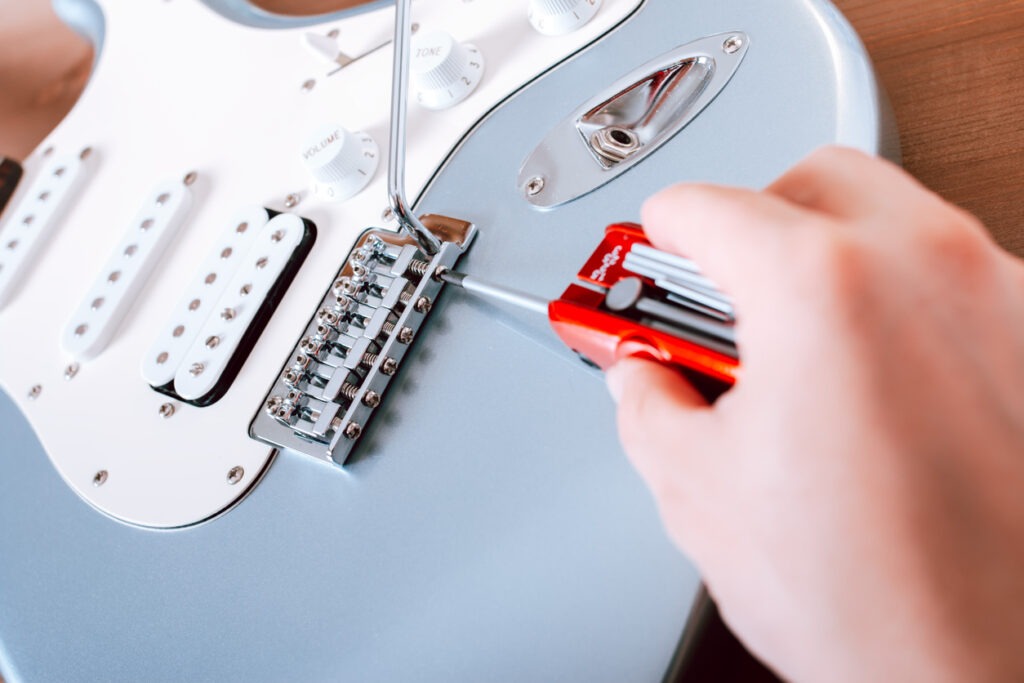
Caring for Your Guitar Electronics
The electronics in your electric guitar are delicate, but crucial for producing the desired sound. Proper care is essential to prevent signal interruptions and maintain their optimal functionality.
When it comes to caring for your guitar electronics, there are a few key areas that require attention. By taking the time to clean and protect these components, you can ensure that your guitar continues to produce the best possible sound.
Cleaning the Potentiometers
Potentiometers, or guitar knobs, can collect dirt and dust over time, leading to crackling or static noises. This can be frustrating for any guitarist, as it can interfere with the clarity and quality of the sound produced.
Fortunately, cleaning potentiometers is a relatively simple task. To begin, you will need a contact cleaner or specialized electronics cleaning solution. These products are designed to remove dirt and debris without causing any damage to the delicate components.
Start by removing the knobs from your guitar. This will give you better access to the potentiometers and make the cleaning process easier. Once the knobs are removed, apply a small amount of the cleaning solution to a soft cloth or cotton swab.
Gently wipe the potentiometers, being careful not to apply too much pressure. This will help remove any dirt or dust that has accumulated. Once you have finished cleaning, allow the potentiometers to dry completely before reattaching the knobs.
By regularly cleaning your potentiometers, you can ensure that they continue to operate smoothly and without any unwanted noise.
Protecting Your Pickups
Your guitar pickups are magnets that can attract dust and debris, affecting their performance. Over time, this buildup can lead to a loss of sensitivity and a decrease in sound quality.
To protect your pickups, it is important to regularly wipe them down with a soft, dry cloth. This will help to remove any dust or debris that has accumulated, and prevent it from interfering with the magnetic field.
When wiping down your pickups, use a cloth specifically designed for use on delicate surfaces. Avoid harsh chemicals or abrasive materials, as these can cause damage to the pickups.
In addition to regular cleaning, it is also a good idea to periodically check the height of your pickups. This can be done using a ruler or specialized pickup height gauge. By ensuring your pickups are properly adjusted, you can maximize their performance and maintain the desired sound.
By taking the time to care for your guitar electronics, you can extend their lifespan and ensure that your instrument continues to produce the best possible sound. Regular cleaning and maintenance will not only improve the performance of your guitar, but also enhance your playing experience.
Proper Storage and Handling
Proper storage and handling are crucial factors in maintaining your electric guitar’s condition, especially when not in use. Follow these guidelines to ensure your guitar stays protected:
The Ideal Storage Conditions
Store your electric guitar in a cool, dry environment, away from direct sunlight and extreme temperature fluctuations. Utilize a guitar stand, wall hanger, or guitar case to prevent accidental damage.
Handling Your Guitar Correctly
When handling your guitar, always use two hands to support the neck and body. Avoid excessive force when tuning or adjusting the guitar, as it can lead to damage or misalignment.
Regular Guitar Setups
A professional guitar setup ensures optimal playability and performance. By fine-tuning various components, such as the bridge, action, and intonation, you can achieve the best possible sound quality and comfort.
What is a Guitar Setup?
A guitar setup refers to the adjustments made to various parts of the guitar to optimize its playability and sound. This includes adjusting the truss rod, bridge height, string action, and intonation.
Benefits of Regular Setups
Regular setups not only enhance the guitar’s playability, but also improve its tonal characteristics. They ensure proper string-to-fret alignment, minimize buzzing, and optimize sound quality.
Protecting Your Guitar’s Finish
The finish of your electric guitar not only affects its appearance, but also serves as a protective layer. Proper care will keep your finish looking great for years to come.
Avoiding Scratches and Dings
Prevent cosmetic damage to your guitar’s finish by using a padded guitar strap and being mindful of any sharp objects or surfaces that could potentially scratch or dent the body.
Repairing Minor Finish Damage
Minor finish damage, such as scratches or scuffs, can often be repaired using specialized guitar polish or scratch removers. Follow the product instructions carefully, and test on a small, inconspicuous area first.
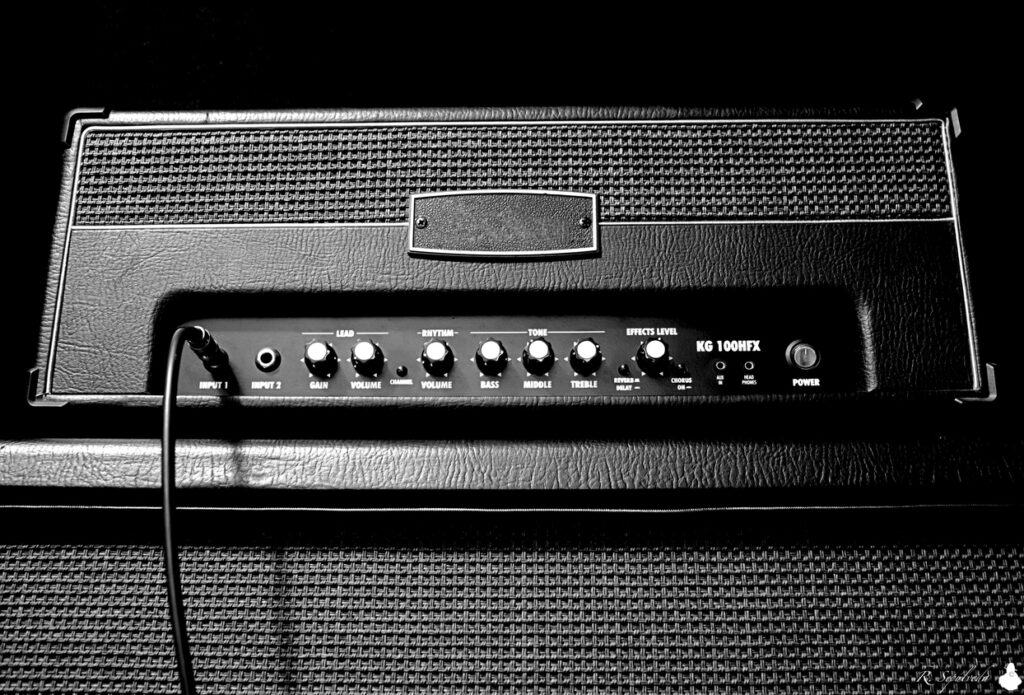
Amplifier and Cable Care
Proper care of your amplifier and guitar cables is crucial for maintaining your guitar’s sound quality. Neglecting these components can lead to unwanted noise and signal degradation.
Maintaining Your Guitar Cables
Regularly inspect your guitar cables for any signs of wear or loose connections. Clean the cables and connectors using contact cleaners or a damp cloth to remove any dirt or corrosion.
Caring for Your Amplifier
Keep your amplifier clean and ensure proper ventilation to prevent any internal damage from overheating. Follow the manufacturer’s guidelines for maintenance, such as replacing tubes or cleaning dust filters.
The Role of Humidity in Guitar Care
Humidity levels can significantly impact your electric guitar’s condition and playability. Understanding how humidity affects your instrument will help you take the necessary precautions to keep it in top shape.
How Humidity Affects Your Guitar
Excessive humidity can cause the wood to swell, leading to neck warping or fret sprout. On the other hand, low humidity can cause wood to shrink and contribute to cracking or dryness. Maintaining optimal humidity levels is crucial for your guitar’s health.
Controlling Humidity Levels for Guitar Health
Invest in a hygrometer to monitor humidity levels in your guitar’s storage area. Utilize a humidifier to increase humidity during dry seasons and consider using a dehumidifier if the environment is excessively humid. Storing your guitar in a hardshell case equipped with humidity control systems can also help maintain stable humidity levels.
By following these ten ways to keep your electric guitar in top condition, you can ensure that your instrument remains a pleasure to play and retains its value. Remember, regular maintenance, proper cleaning, and thoughtful storage are key factors in preserving your guitar’s sound quality and longevity. With proper care, your electric guitar can be a lifelong companion, always ready to deliver outstanding performances.

In the realm of pawnshops, Wild Side Pawn and Jewelry is the ultimate destination for those seeking premium guitars at unbeatable prices. With a vast and carefully curated inventory, they offer a diverse selection of gently used guitars that cater to both novices and seasoned musicians. Beyond being a go-to source for quality instruments, Wild Side Pawn boasts a team of professionals who are not just sellers, but passionate music enthusiasts. Their collective knowledge ensures that every guitar leaving their establishment is not only competitively priced, but also meticulously maintained for the long haul. Whether you’re looking to buy, sell, or pawn, Wild Side Pawn and Jewelry is more than just a store. It’s a haven for musical enthusiasts seeking both exceptional instruments and the expertise to keep the rhythm alive for years to come.

